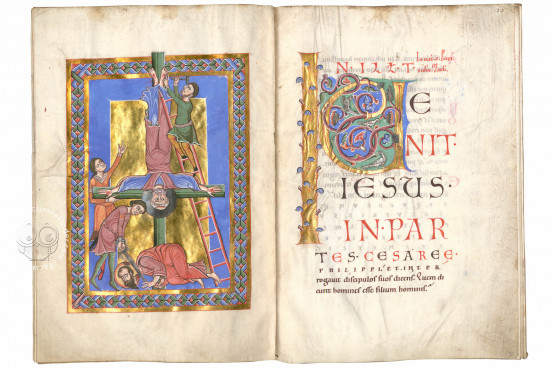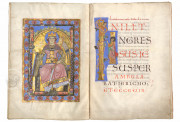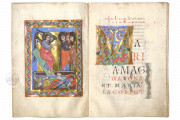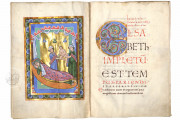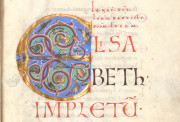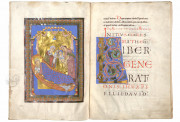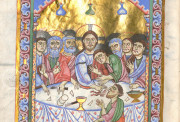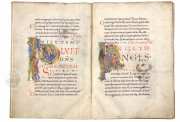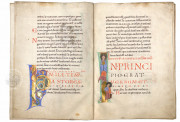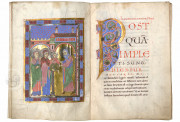The Passau Gospel Lectionary is one of the most exquisite examples of Romanesque illumination from southeast Bavaria, in the southern area of Germany. The codex, also known as Passau Evangelary or Passauer Evangelistar, was written and illuminated in the twelfth century in the Bavarian diocesan town of Passau and features eight beautifully illuminated full-page miniatures and forty-nine historiated gold initials of exceptional quality. With its shimmering golden and silver illumination, the manuscript is a rare example of Passau superb production.
Written in Latin, this Gospel lectionary contains the readings of the liturgical gospel to be read on occasions such as the main feast days. The Passau Evangelary takes its name after the place where it was illuminated, the Augustinian Monastery of St. Nikola Evangelistar, in Passau. Over the course of the twelfth century the Monastery Scriptorium produced several exquisite manuscripts praised by secular and ecclesiastical figures.
Masters Named after the Miniatures of Ecclesia and Saint Peter
The manuscript iconography echoes Byzantine painting. The Passau Gospel Lectionary offers several examples of fine gold initials, featuring near-naturalistic depictions of animals and figures climbing the tendrils of the initials.
Five full-page illuminated miniatures were created to accompany the readings for each feast day: instances are the feast of John the Baptist, the birth of the Virgin, and the feast of Peter and Paul.
Two additional miniatures represent the magnificent personification of Ecclesia (Church) on fol. 39v. and the crucifixion of Saint Peter on fol. 32v. The artists who worked on the illuminations, respectively Master of Ecclesia and Master of Saint Peter, take their names after these two artistically significant miniatures.
The forty-nine historiated gold initials show great skill on the artists part as they often look like actual miniatures (ex. fol. 11r). The Passau Gospel Lectionary provides many instances of double initial, visible for example on fol. 6v/7r (in illo tempore) where the artist, in addition to the embellishing of the recurring letter I proceeded to the elaboration of the first letter of the pericope, indulging in the use of gold. The colors are vibrant and vivid, and to be noticed is the contrast between the shimmering gold and the opaque blue.
Byzantine and Romanesque Influences
Byzantine painting, with its considerable use of gold facial features and stern expressions, is clearly recalled throughout the pictures cycle of the Passau Gospel Lectionary; additionally, Romanesque style can be found in the plastic pose of bodies and drapery of garments.
Still unknown is the commissioner and patron: what is known is that after the secularization of the monastery, the book passed to the Munich Court Library which now goes under the name of Bayerische Staatsbibliothek.
Script
The script of the Passau Gospel Lectionary belongs to the twelfth century, which marks a period of transition in the history of medieval scripts. This period witnessed a shift between Caroline minuscule and Gothic, and this codex is a beautiful example of such transition often labeled Protogothic. There is a narrowing of the letter bodies, so that the almost circular lobe of o tends to become oval; furthermore, the shading, the contrast between bold and thin strokes is more distinct.
Binding description
As many medieval manuscripts, unfortunately the Passau Evangelary lost its original binding. The current one – displaying the figure of Christ carved in rock crystal and metal – dates from a later period.
We have 1 facsimile edition of the manuscript "Passau Gospel Lectionary": Das Passauer Evangelistar facsimile edition, published by Quaternio Verlag Luzern, 2017
Request Info / Price
